BRAVES FIELD (BOSTON)
Braves Field was home to the Boston Braves (sometimes Boston Bees) from 1915-1952. It also played host park for the Boston Red Sox in the 1915 and 1916 World Series.
Opening Field dimensions
Left Field - 402 ft
Left-center - 402 ft
Center field 440 ft
Right-center - 402 ft
Right field - 402 ft
The Braves played in Braves Field for 38 years, and in 24 of those seasons they changed the outfield dimensions.
Final Field dimensions
Left field - 337 ft
Left-center - 355 ft
Center field 390 ft
Right-center - 355 ft
Right field - 319 ft
The most distinctive feature of this park was the vast expanse of outfield grass from foul line to foul line. Ty Cobb once said that no one would ever hit a ball out of Braves Field, and, indeed, it was nearly a decade before Frank "Pancho" Snyder conquered the left field wall. It wasn't until 1928 that the fences were moved inward and home runs became commonplace.
June 1937, a rare sellout at Braves Field
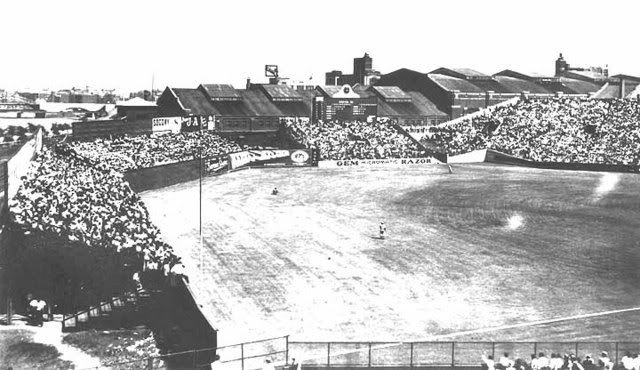
1930s aerial of Braves Field. You can tell how expansive Braves Field was when it opened by looking at the walls behind the outfield bleachers. These were the original outfield walls.
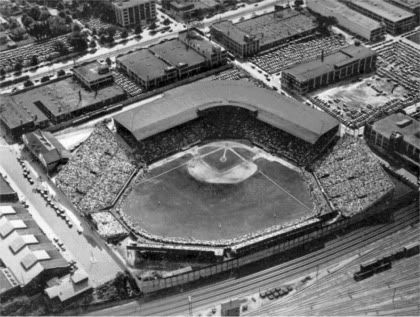
The Jury Box Bleachers in right field. Named after a sportswriter noticed during one slow mid-week game that there were only twelve individuals sitting in the 2,000-seat stand.
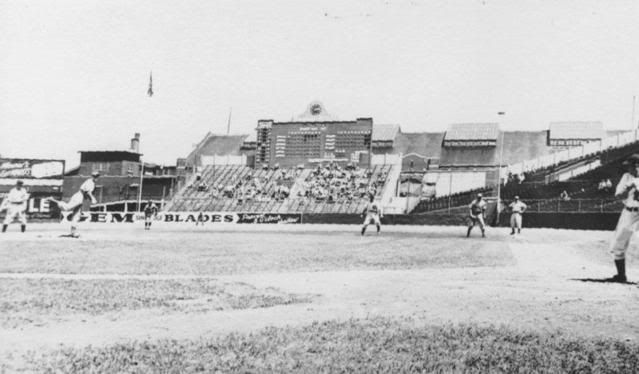
Braves Field Outfield Fence. The Kansas City A's bought the scoreboard and had it moved to Kansas City' Municipal Stadium in 1955

Here are the aces of the 1948 pennant-winning Braves, Warren Spahn and Johnny Sain, although, contrary to legend, teammates Bill Voiselle (13–13), and Vern Bickford (11–5) also pitched well. In honor of the pitching duo, Boston Post sports editor Gerald V. Hern wrote this poem which the popular media eventually condensed to "Spahn and Sain and Pray for Rain":
First we'll use Spahn
then we'll use Sain
Then an off day
followed by rain
Back will come Spahn
followed by Sain
And followed
we hope
by two days of rain.
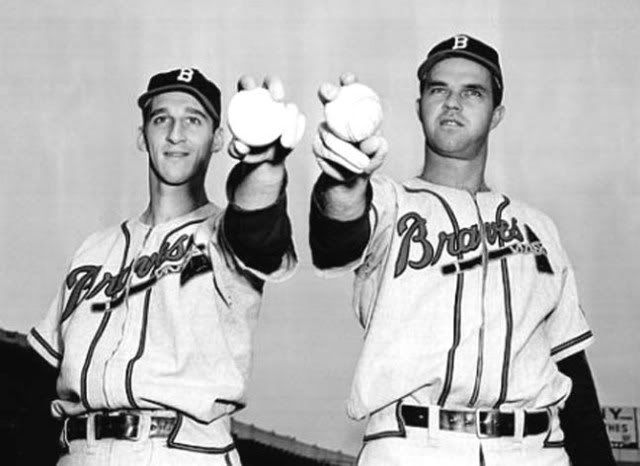
Rookie Eddie Mathews' first year (1952) with the Braves was their last in Boston before moving to Milwaukee.
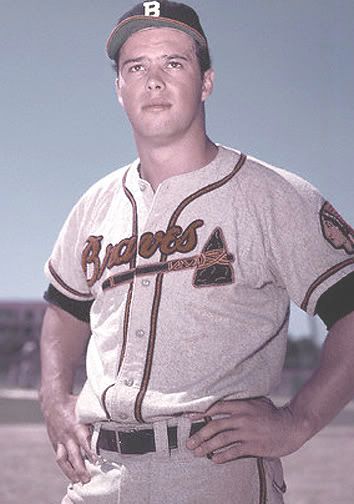
September 1951, Dodgers visiting Boston. Rundown with Roy Campanella involved. One look into the stands is a pretty good indicator of why the Braves moved to Milwaukee in 1953.
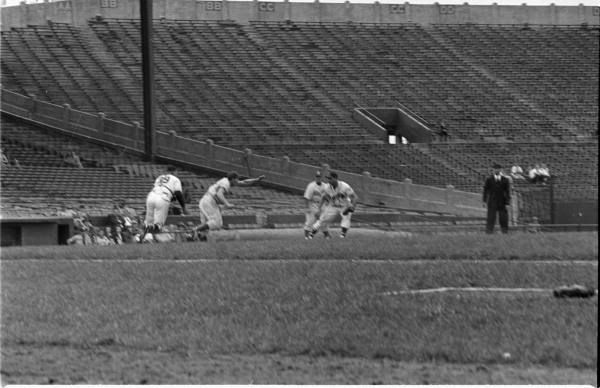
Opening Day 1952, the Braves last in Boston. Quite a sparse crowd for opening day.
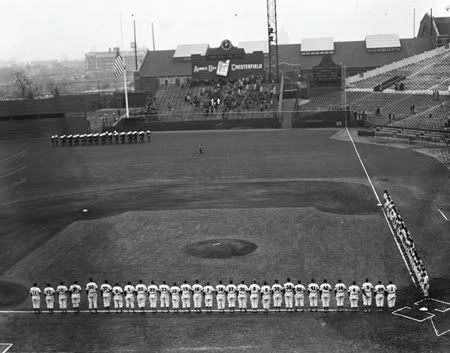
What is left of Braves Field today. After the Braves left in 1953, Boston University purchased the property, converted it for football and changed its name to Nickerson Field, where the B.U. Terriers played football until 1997. Field hockey and soccer games as well as commencement ceremonies are still held there. The old right-field pavilion pictured below was incorporated into Nickerson's seating arrangement.
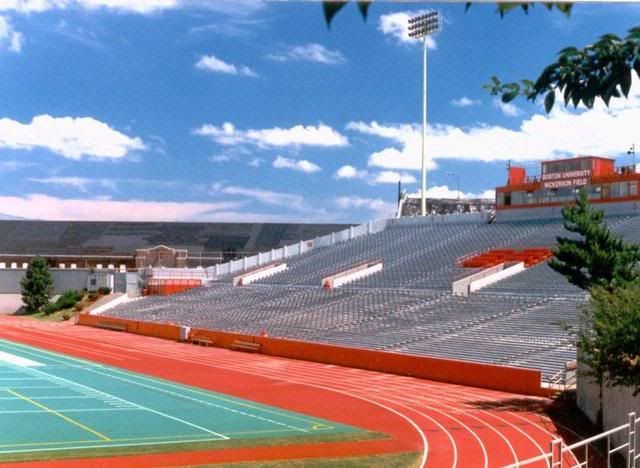
Opening Field dimensions
Left Field - 402 ft
Left-center - 402 ft
Center field 440 ft
Right-center - 402 ft
Right field - 402 ft
The Braves played in Braves Field for 38 years, and in 24 of those seasons they changed the outfield dimensions.
Final Field dimensions
Left field - 337 ft
Left-center - 355 ft
Center field 390 ft
Right-center - 355 ft
Right field - 319 ft
The most distinctive feature of this park was the vast expanse of outfield grass from foul line to foul line. Ty Cobb once said that no one would ever hit a ball out of Braves Field, and, indeed, it was nearly a decade before Frank "Pancho" Snyder conquered the left field wall. It wasn't until 1928 that the fences were moved inward and home runs became commonplace.
June 1937, a rare sellout at Braves Field

1930s aerial of Braves Field. You can tell how expansive Braves Field was when it opened by looking at the walls behind the outfield bleachers. These were the original outfield walls.

The Jury Box Bleachers in right field. Named after a sportswriter noticed during one slow mid-week game that there were only twelve individuals sitting in the 2,000-seat stand.

Braves Field Outfield Fence. The Kansas City A's bought the scoreboard and had it moved to Kansas City' Municipal Stadium in 1955

Here are the aces of the 1948 pennant-winning Braves, Warren Spahn and Johnny Sain, although, contrary to legend, teammates Bill Voiselle (13–13), and Vern Bickford (11–5) also pitched well. In honor of the pitching duo, Boston Post sports editor Gerald V. Hern wrote this poem which the popular media eventually condensed to "Spahn and Sain and Pray for Rain":
First we'll use Spahn
then we'll use Sain
Then an off day
followed by rain
Back will come Spahn
followed by Sain
And followed
we hope
by two days of rain.

Rookie Eddie Mathews' first year (1952) with the Braves was their last in Boston before moving to Milwaukee.

September 1951, Dodgers visiting Boston. Rundown with Roy Campanella involved. One look into the stands is a pretty good indicator of why the Braves moved to Milwaukee in 1953.

Opening Day 1952, the Braves last in Boston. Quite a sparse crowd for opening day.

What is left of Braves Field today. After the Braves left in 1953, Boston University purchased the property, converted it for football and changed its name to Nickerson Field, where the B.U. Terriers played football until 1997. Field hockey and soccer games as well as commencement ceremonies are still held there. The old right-field pavilion pictured below was incorporated into Nickerson's seating arrangement.
